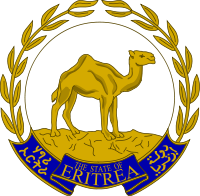- Coat of arms of Eritrea
-
The Coat of arms of Eritrea was adopted 24 May 1993 on the occasion of the declaration of independence from Ethiopia. The emblem mainly depicts a camel surrounded by a wreath of laurel. Previously, as a colony of the Kingdom of Italy, traditional European heraldry had been introduced, but by 1952 the European heraldic traditions were abandoned as other emblems were adopted to represent the region.
History
Eritrea was first assigned a coat of arms in 1919 as a colony of the Kingdom of Italy. The shield was parted in half horizontally, with the top portion displaying a red lion charged on his breast with a white star and the bottom half divided into six wavy bars alternating blue and white. The red lion represents the Italian Kingdom, lions alluding to the Italian King who used the beasts as supporters and red being a common colour associated with Italy and also used by the ruling House of Savoy. The star has long been a symbol of the Italian people, known as the Stellone d'Italia, which protects and guards the nation. The bottom portion displaying blue and white wavy bars is a common heraldic depiction representing water, and alludes to the origins of the colony's name. Eritrea is derived from the Latin Erythræa, the name applied to the Red Sea in antiquity; the colony was named so for its coastline along that body of water.[1]
During the Fascist regime of Italy, which began in 1926, the arms were augmented with symbols of the new government. A red chief was added, which was charged with fasces and laurel wreath. Eritrea was then absorbed into the colony of Italian East Africa in 1936, reducing it to a province of the new and larger colony. In 1941, when the province was liberated and placed under British administration, the fascist chief was promptly removed and the original arms were again employed. In 1951, the process of annexation by Ethiopia began, and the arms continued in use until the following year.[1]
During the annexation period, from 1952 to 1962, an emblem was adopted that consisted of a vertical olive branch encircled by an olive wreath. This emblem is used still on the nation's flag.[1]
The modern emblem was adopted 24 May 1993, the date of the declaration of independence from Ethiopia. It shows a scene of a dromedary camel in the desert, which is surrounded by an olive wreath. The camel was the beast of burden used during the war of independence from Ethiopia to transport supplies and goods, and was seen as being instrumental to the movements success and the symbol of the nationalists.[2] The name of the country appears on a scroll towards the bottom of the emblem threefold, in Tigrinya, English and Arabic, the three official languages of the state.[1]

The emblem of Eritrea during
Ethiopean annexation from
1952 to 1962.See also
References
- ^ a b c d "National Arms of Eritrea". Heraldry of the World. http://www.ngw.nl/int/afr/er-nat.htm. Retrieved 20 September 2009.
- ^ "Eritrean Government". Embassy of The State of Eritrea, Stockholm. http://www.eritrean-embassy.se/State_Structure.htm. Retrieved 7 May 2010.
Coats of arms and emblems of Africa Sovereign
states- Algeria
- Angola
- Benin
- Botswana
- Burkina Faso
- Burundi
- Cameroon
- Cape Verde
- Central African Republic
- Chad
- Comoros
- Democratic Republic of the Congo
- Republic of the Congo
- Côte d'Ivoire (Ivory Coast)
- Djibouti
- Egypt
- Equatorial Guinea
- Eritrea
- Ethiopia
- Gabon
- The Gambia
- Ghana
- Guinea
- Guinea-Bissau
- Kenya
- Lesotho
- Liberia
- Libya
- Madagascar
- Malawi
- Mali
- Mauritania
- Mauritius
- Morocco
- Mozambique
- Namibia
- Niger
- Nigeria
- Rwanda
- São Tomé and Príncipe
- Senegal
- Seychelles
- Sierra Leone
- Somalia
- South Africa
- South Sudan
- Sudan
- Swaziland
- Tanzania
- Togo
- Tunisia
- Uganda
- Zambia
- Zimbabwe
States with limited
recognition- Sahrawi Arab Democratic Republic
- Somaliland
Dependencies and
other territories- Canary Islands / Ceuta / Melilla / Plazas de soberanía (Spain)
- Madeira (Portugal)
- Mayotte / Réunion (France)
- Saint Helena / Ascension Island / Tristan da Cunha (United Kingdom)
- Western Sahara
Categories:- National emblems
- National symbols of Eritrea
- Eritrea stubs
- Heraldry stubs
Wikimedia Foundation. 2010.

